Choosing the Right Hospital Flooring Options for Healthcare Facilities:
Choosing the right flooring for hospitals and healthcare facilities is about more than just looks. It’s a vital decision that affects infection control, safety, and long-term use. You also have to meet all the official rules. Hospital floors face tough conditions every day. These include constant foot traffic, heavy equipment, and spills. A major goal is to lower the number of infections that patients get in the hospital (HAIs).
Key Flooring Criteria for Healthcare Facilities
Healthcare flooring needs to be smooth and non-porous to keep out moisture and bacteria. In areas with higher infection risk, the floor should curve up the wall by at least 6 inches to create a sealed edge. It also has to handle chemical exposure, stains, and heavy equipment, while staying easy to clean every day. Most importantly, it should meet all the performance standards required for medical use.
I advise design teams to carefully review the technical needs and the conditions at the site. You must find a flooring solution that balances performance, long-term costs, infection control, and appearance. I am confident that the right choice protects both patients and staff and helps the facility run well.
1. Sheet Vinyl Flooring: Seamless, Hygienic, and Cost-Effective Option for Hospitals
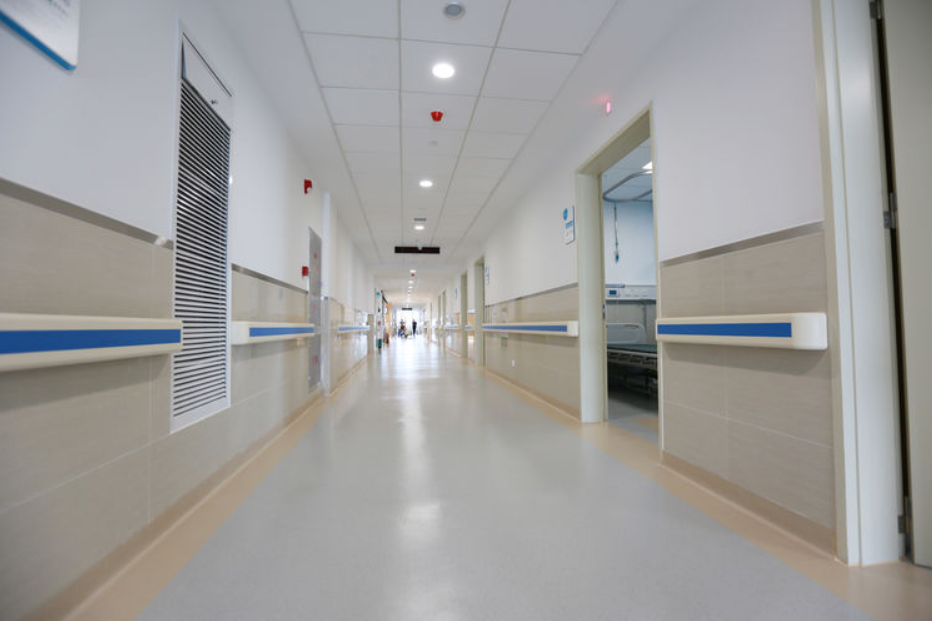
From my experience, I see sheet vinyl flooring used in many modern hospitals. I believe it’s a top choice because it creates a seamless surface that helps with infection control. It comes in wide rolls, often up to six feet, which means fewer seams are needed. We then heat-weld each joint. This process forms a watertight surface and stops germs and fluids from seeping through.
Advantages of Sheet Vinyl for Healthcare Facilities
Infection Control: Because it has fewer seams and welded joints, sheet vinyl helps stop bacteria from growing. It also makes it easier for cleaning crews to clean every part of the floor. In my opinion, this is a huge improvement over tile, which has many grout lines where dirt and germs can hide.
Durability and Maintenance: You can get sheet vinyl in different constructions, such as solid (homogeneous) or layered (heterogeneous). I find both types stand up well to frequent cleaning, heavy equipment, and spills. Its smooth, non-absorbent surface makes cleaning quick and inexpensive. This lowers long-term maintenance costs compared to materials that stain easily.
Flexible Design Options: Hospitals can pick from a wide variety of visuals, colors, and patterns. This freedom makes it simple to design spaces that feel calm and functional. You can also use different designs to create separate zones based on what an area is used for.
Integral Coving for Hygiene: I recommend using integral coving for the best hygiene. This is where the flooring curves up the wall by at least six inches. The Facility Guidelines Institute suggests this for high-risk areas. It creates a smooth, dirt-proof corner between the floor and the wall. This is essential for operating rooms, imaging suites, delivery rooms, and labs. Facilities that prioritize hygiene and performance often choose healthcare-grade sheet vinyl over tile or laminate alternatives.
Technical Excellence and Proven Performance
Manufacturers stress the value of heat-welded seams and a single-piece installation in all hospital areas where controlling infection is important. I agree this is a priority. Some new systems, like Geometrix, allow contractors to install custom-fit floors faster and with less disruption to hospital activities.
I recommend sheet vinyl over tile in any area sensitive to infection. It removes most joints and makes cleaning more thorough. Its reliability and good price make it a leading option for hospitals and healthcare centers that need safe, clean, and lasting performance.
2. Rubber Flooring: High-Performance, Seamless, and Hygienic Option for Hospitals
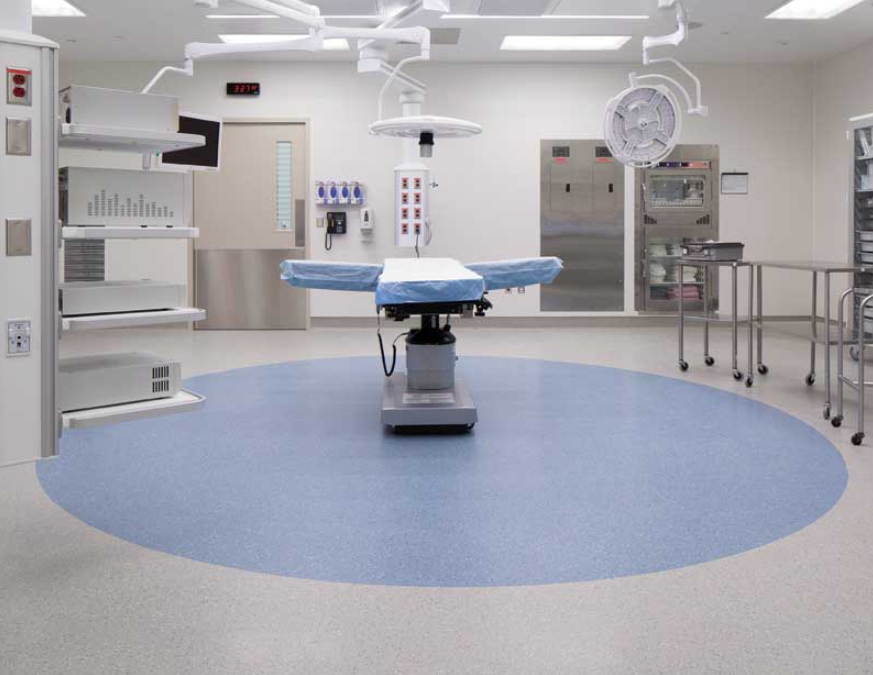
I often recommend rubber flooring for hospitals. It’s a top choice because it’s safe, clean, and lasts a long time. Rubber is a material that does not absorb liquids, which stops moisture, bacteria, and spills from seeping in.
For installation, I suggest using heat-welded seams and integral coving. This means the flooring extends at least six inches up the wall, following the Facility Guidelines Institute (FGI) standards. This method creates a perfectly smooth surface that is easy to disinfect. This single, solid surface leaves no gaps where dirt and germs can hide. I find this essential for infection control in patient wings, operating rooms, and labs.
Key Benefits of Rubber Flooring for Healthcare Facilities
Slip Resistance: From my experience, rubber floors offer excellent grip. This reduces the risk of falls, even in busy, wet areas like hospital hallways or kitchens.
Superior Durability: This flooring is incredibly tough. It is designed to handle heavy foot traffic, rolling equipment, and tough cleaning routines. For example, I’ve seen Mondo’s hospital-grade rubber flooring, which is a solid 3 millimeters thick and includes a 15-year wear warranty.
Long-Term Cost Efficiency: The initial cost to install rubber is higher than for vinyl or linoleum. But because it lasts so long, you save money on maintenance and replacement costs over its lifetime. I see it as a smart investment.
Underfoot Comfort: The springy feel of rubber adds comfort. This helps reduce fatigue for staff who spend all day on their feet.
Design Flexibility: You can get rubber flooring in many solid colors and simple textures. It creates a clean, professional look that suits clinical spaces without being overpowering.
Regulatory Compliance: I can confirm that rubber flooring meets or goes beyond healthcare rules for fire safety, infection control, and seamless installation. This includes using coved bases in sterile and high-risk zones.
3. My Guide to LVT Flooring in Healthcare: A Durable and Clean Choice
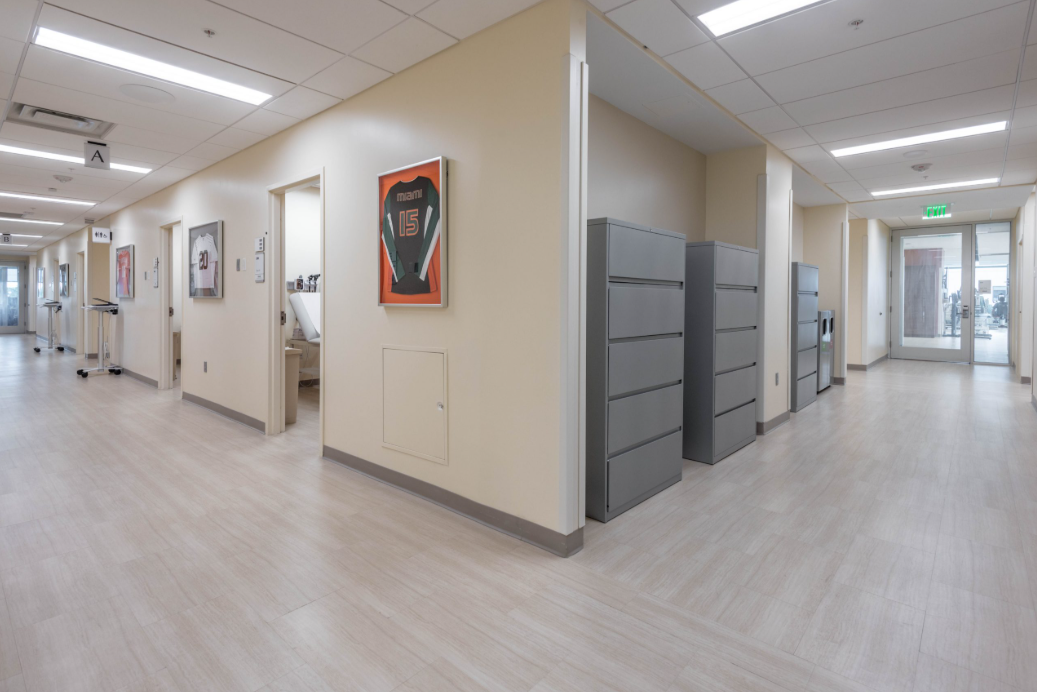
Based on my experience, Luxury Vinyl Tile (LVT) is a top flooring choice for hospitals. It performs well, is safe, and offers great design options.
Key Benefits I See with LVT in Healthcare
Safety & Infection Control:
LVT is great for hygiene because it is non-porous. It resists water and stains, which helps keep hospitals clean. I suggest a textured surface for better grip. This reduces the risk of falls and meets Facilities Guidelines Institute (FGI) recommendations.
I recommend square-edge construction. It leaves fewer gaps where germs can hide. This makes cleaning simpler and more effective.
Durability in High-Traffic Areas:
LVT is built with a layered structure. It has a solid backing, a printed design layer, and a commercial-grade wear layer. For healthcare settings, I suggest a wear layer of at least 20 mils thick. Protective coatings like UV-cured urethane defend the floor against scratches, stains, and scuffs.
This toughness makes LVT perfect for busy corridors, waiting rooms, and patient care areas. These spaces face constant foot traffic and equipment movement.
For high-traffic zones like corridors and patient areas, commercial LVT flooring provides a 20+ mil wear layer and UV-cured coating for long-lasting performance.
Easy Maintenance and Repairs: Hospital cleaning staff (EVS) appreciate the square-edge design. It makes their job of cleaning the floors much easier.
LVT comes in tiles and planks. If a section gets damaged, you can replace just that piece. This process is fast, keeps costs down, and causes little disruption.
Luxury vinyl tiles for healthcare settings are modular and easy to repair, minimizing downtime and reducing operational costs.
Acoustic Performance: I find that LVT helps quiet down noisy places. It absorbs sound in busy hallways and patient rooms. This creates a more peaceful environment for privacy and patient recovery. Modular LVT flooring supports future layout changes without compromising visual consistency or hygiene standards.
Design Flexibility: With modern digital printing, LVT can look like natural wood, stone, or abstract patterns. This gives you endless design choices.
I have seen hospitals use these visuals to help people find their way, build their brand, and create calming rooms.
The modular tiles and planks also let you change layouts and styles as your needs grow.
Cost-Effectiveness: From my point of view, LVT is a smart budget choice. The material and installation costs are often lower than other options. You also save money over the long term because it is so easy to maintain and repair.
4. Sheet Linoleum: Sustainable, Seamless Flooring for Hospitals and Healthcare Facilities
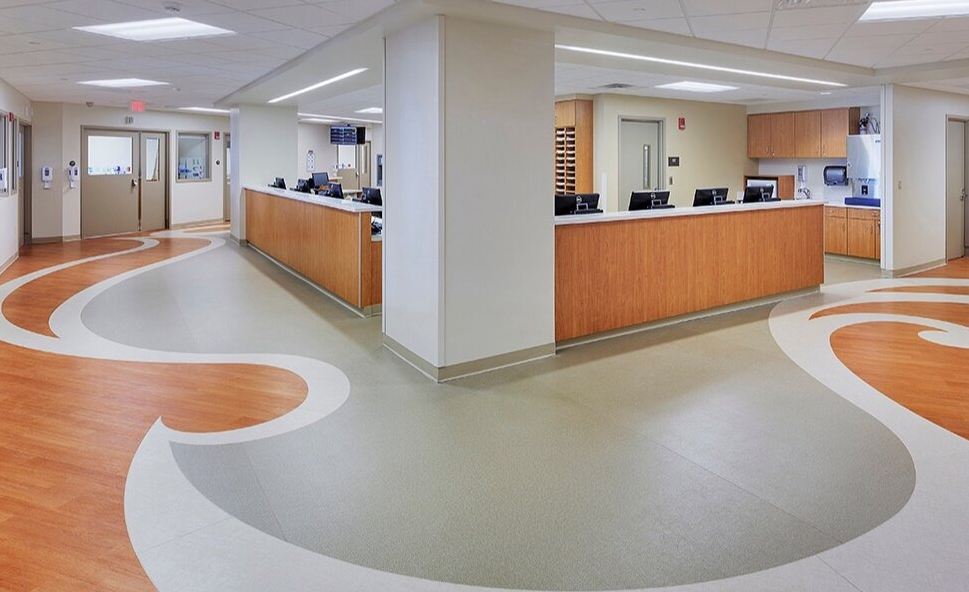
Sheet linoleum is a dependable and tough flooring. It should be recommended for hospitals and healthcare settings because it’s sustainable, installs without seams, and is very durable.
Key Benefits of Sheet Linoleum in Healthcare
A Seamless Surface for Better Hygiene:
Installers use heat-welded seams to create a single, continuous surface. This method stops bacteria from growing in joints or cracks. It also meets the Facility Guidelines Institute’s (FGI) rule for coved bases that extend six inches up the wall. A seamless edge is vital for keeping critical areas like operating rooms, labs, and imaging suites clean.
Excellent Infection Control:
The lack of seams and the built-in cove base make these floors easy to disinfect. For example, I’ve seen great results with Tarkett’s iQ homogeneous sheet linoleum. It helps reduce the spread of germs. You just need to dry buff it to restore its finish, with no need for wax or chemicals, even in busy hospital corridors.
Made from Natural Materials:
I appreciate that sheet linoleum comes from all-natural, renewable sources. The ingredients include linseed oil, pine rosin, cork or wood flour, and natural pigments on a polyester backing. This makeup means low VOC emissions and better indoor air quality, which helps hospitals meet their wellness goals.
Long-Term Durability and Easy Maintenance:
Linoleum is very durable and holds up well to heavy hospital use. Its surface resists scratches, and its solid construction makes it simple to clean. You do not need to wax it regularly, which keeps ownership costs down compared to other flooring. For daily upkeep, a simple dry buffing is all you need.
Proven Performance and Use in the Market:
I see architects and designers choose linoleum for large hospital projects, often covering thousands of square feet. While it might be used less than sheet vinyl or rubber, its reputation for strength makes it a go-to choice for demanding areas.
Flexible Design and Compliance:
Sheet linoleum comes in many colors and patterns. This allows for custom designs, clear wayfinding, and creating calm spaces for patients. I suggest you ensure it meets industry standards like ASTM F2195. Look for tiles at least 450 mm (18 inches) square and a minimum thickness of 2.0 mm (0.08 inches).
5. Epoxy Flooring (Resinous Flooring): Ultra-Hygienic, Durable, and Safe for Hospitals
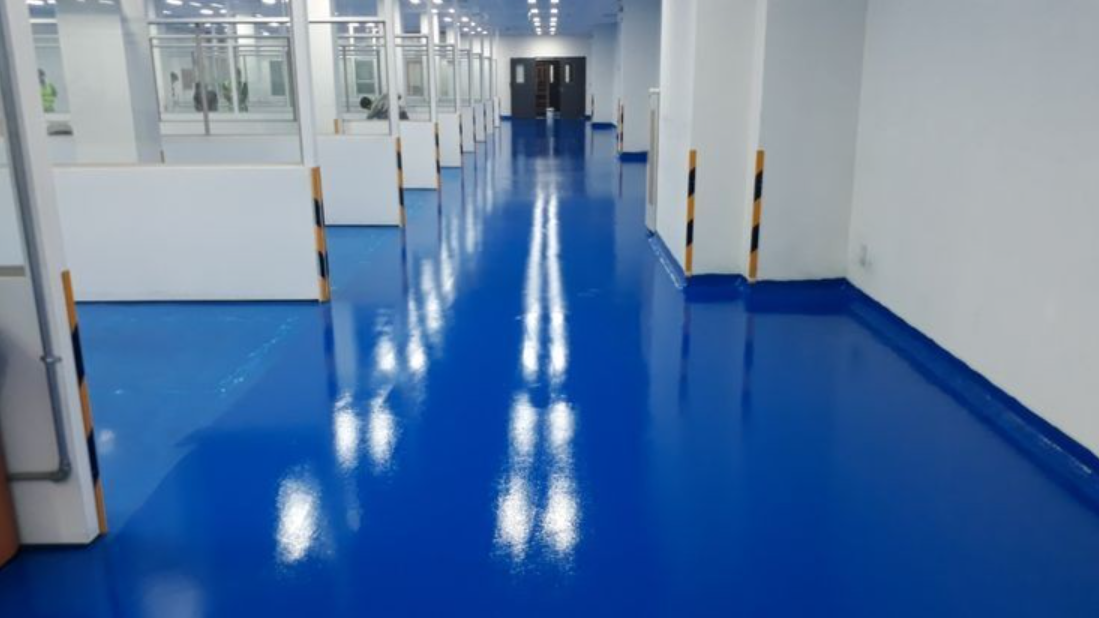
And epoxy flooring, also called resinous flooring, is a top choice for hospitals. In healthcare settings, you must have floors that are extremely clean, tough, and safe. From my experience, epoxy delivers on all three points.
Key Benefits of Epoxy Flooring in Healthcare
Hygiene and Infection Control:
Epoxy offers a single, smooth surface with no pores or seams. And this stops fluids like blood and urine from soaking in, and prevents bacteria and mold from growing, which I find is crucial for controlling infection in surgical suites and labs. So, adding antimicrobial agents during installation for an extra layer of germ protection. You can also have the floor curve up the wall edges. This removes corners where dirt builds up, making deep cleaning much more effective. Epoxy flooring meets or exceeds Federal USDA standards for medical use.
Durability and Chemical Resistance:
Hospitals have constant foot traffic and heavy rolling equipment. Epoxy is built to handle this. It resists scuffs, scratches, and the harsh cleaning chemicals used in hospitals. I like that the surface handles strong detergents and disinfectants without damage. This means fewer repairs and a longer life, often lasting 10 to 20 years with proper care. This lowers maintenance costs and facility downtime, a huge practical advantage for any busy hospital.
Maintenance Simplicity:
These floors are simple to care for. Mopping with a neutral cleaner is often enough. Because there are no grout lines or joints, I’ve found there are no hidden places for dirt or bacteria to hide. This simplifies cleaning routines and helps meet the strict sanitation protocols in healthcare.
Safety and Usability Advantages
Slip Resistance:
I recommend using textured finishes, such as ribbed, pebbled, or marble chip surfaces. These help prevent slips and falls while still being comfortable to walk on. Data from manufacturers shows that choosing the right texture can reduce slip accidents by up to 50% in hospitals.
Color Zoning for Wayfinding:
With epoxy, you can create clear color-coded sections on the floor. These colors can guide staff and patients to surgery areas, potentially hazardous zones, or different corridors. I think this is a great way to improve how people get around and increase overall safety.
In summary:
Epoxy flooring is a fundamental choice for hospital construction and remodeling projects. It combines seamless hygiene, heavy-duty strength, and built-in safety better than most other materials. I feel it is a smart, long-lasting investment for any healthcare facility that focuses on patient safety, low maintenance, and cost control.
6. Terrazzo Flooring: A Durable, Seamless, and Clean Choice for Hospitals
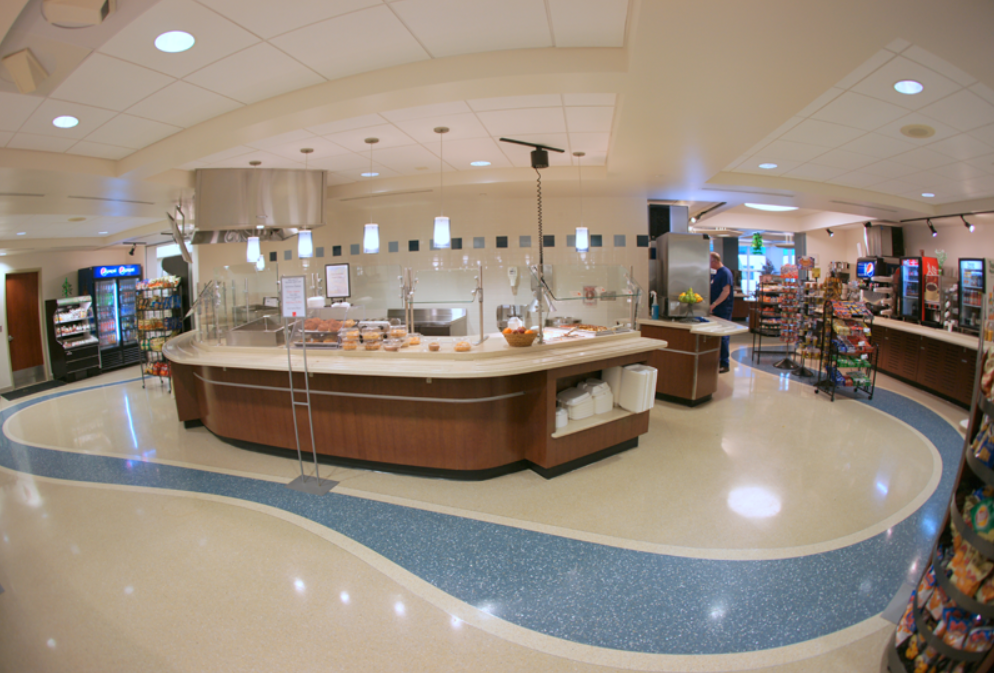
Terrazzo flooring is a top choice for hospitals. I recommend it because it is strong, easy to maintain, and helps control infections.
Why I Suggest Terrazzo for Healthcare Buildings
Lifespan:
I find that epoxy terrazzo flooring holds up well under heavy foot traffic. It handles the constant movement in hospital lobbies, hallways, and emergency rooms. I’ve seen it last for the entire life of a building. Other floors often need repairs or complete replacement. Terrazzo, however, can cover large areas for decades with very little upkeep. This makes it a smart investment that saves money over time.
Smooth Surface:
When installing terrazzo, we create a surface with no joints or grout lines. which means there are no cracks for dirt, spills, or germs like MRSA to hide. So, this is vital for hospitals to meet strict cleanliness standards.
Terrazzo also provides good grip when wet or dry, which helps keep staff and patients safe.
Clean and Maintain:
You can clean the floor each day with just a mop and warm water. You don’t need strong chemicals, wax, or special stripping. Because it resists stains and chemicals, the floor looks great with very little work.
Creative Designs for Healing Environments:
You can design terrazzo with different colors, patterns, and logos. This can improve a hospital’s branding or create a more comforting space for patients. I’ve seen hospitals use terrazzo everywhere, from lobbies and patient rooms to cafeterias and kitchens. It works anywhere you need a clean, tough surface.
Technical and Safety Information
Following NTMA Standards:
Installers must follow the standards set by the National Terrazzo & Mosaic Association (NTMA). For any project larger than 5,000 square feet, installers first create a 48-inch-square sample. They check this sample carefully before starting the full installation.
Meeting Safety Rules:
Terrazzo floors meet ADA requirements for slip resistance. They are fully approved for use in the demanding, regulated environment of a hospital.
